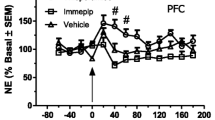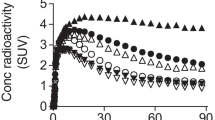Abstract
To compare in vivo effects of eleven compounds of different classes of histamine H1-receptor antagonists (alcoholamines: diphenhydramine, carbinoxamine, and clemastine; ethylenediamines: mepyramine, tripelennamine, and clemizole; alkylamines: triprolidine and chlorpheniramine; piperazines: meclizine and homochlorcyclizine; phenothiazines: promethazine) on neuronal uptake of dopamine (DA), noradrenaline (NA), and 5-hydroxytryptamine (5-HT), the effects on the turnover of these monoamines were examined in the mouse brain, based on the a-methyl-p-tyrosine-induced depletion of DA and NA or probenecid-induced accumulation of 5-hydroxyindoleacetic acid. The DA turnover was reduced remarkably by diphenhydramine, tripelennamine, and promethazine, and also significantly by chlorpheniramine, mepyramine, clemizole, and homochlorcyclizine, at doses used in the ordinary animal experiments. The 5-HT turnover was reduced markedly by mepyramine, tripelennamine, and chlorpheniramine. In contrast, the NA turnover was increased by promethazine and homochlorcyclizine, possibly due to their antagonistic effects on α-adrenoceptors. These results suggest that (1) the degree of inhibition of the uptake of DA and 5-HT by histamine H1-receptor antagonists is considerably different, (2) most Ht-antagonists have little influence on NA uptake and some compounds enhance NA release, and that (3) carbinoxamine, clemastine, triprolidine, and meclizine have comparatively weak influences on monoamine metabolism. These effects on brain monoamine systems may be related to some central actions of histamine H1-receptor antagonists, such as an addiction to these compounds combined with opioids.
Similar content being viewed by others
References
Awouters FHL, Niemegeers CJE, Janssen PAJ (1983) Pharmacology of the specific histamine H1-antagonist astemizole. Arzneimittelforschung 33:381–388
Bergman J, Spealman RD (1988) Behavioral effects of histamine H1 antagonists: comparison with other drugs and modification by haloperidol. J Pharmacol Exp Ther 245:471–478
Brase DA (1979) Roles of serotonin and gamma-aminobutyric acid in opioid effects. In: Loh HH, Ross DH (eds) Neurochemical mechanisms of opiates and endorphins. Adv Biochem Psychopharmacol, Vol 20. Raven, New York, pp 409–428
Brown PA, Vernikos J (1980) Antihistamine effect on synaptosomal uptake of serotonin, norepinephrine and dopamine. Eur J Pharmacol 65:89–92
Butch AJ, Yokel RA, Sigell LT, Hanenson IB, Nelson ED (1979) Abuse and pulmonary complication of injecting pentazocine and tripelennamine in tablets. Clin Toxicol 14:301–306
Carlsson A, Lindqvist M (1978) Effects of antidepressant agents on the synthesis of brain monoamines. J Neural Transm 43:73–91
Coyle JT, Snyder SH (1969) Antiparkinsonian drugs: Inhibition of dopamine uptake in the corpus striatum as a possible mechanism of action. Science 166:899–901
Garrison JC (1990) Histamine, bradykinin, 5-hydroxytryptamine, and their antagonists. In: Gilman AG, Rall TW, Nies AS, Taylor P (eds) The pharmacological basis of therapeutics. Pergamon, New York, pp 575–599
Kopera J, Armitage AK (1954) Comparison of some pharmacological properties of chlorpromazine, promethazine, and pethidine. Br J Pharmacol 9:392–401
Lidbrink P, Jonsson G, Fuxe K (1971) The effect of imipramine like drugs and antihistamine drugs on uptake mechanisms in the central noradrenaline and 5-hydroxytryptamine neurons. Neuropharmacology 10:521–536
Miller FP, Cox RH Jr, Snodgrass WR, Maickel RP (1970) Comparative effects of p-chlorophenylalanine, p-chloroamphetamine and pchloro-N-methylamphetamine, on rat brain norepinephrine, serotonin and 5-hydroxyindole-3-acetic acid. Biochem Pharmacol 19:435–442
Perrone MH, Luttinger D, Hamel LT, Fritz PM, Ferraino R, Haubrich DR (1990) In vivo assessment of napamezole, an alpha-2 adrenoceptor antagonist and monoamine re-uptake inhibitor. J Pharmacol Exp Ther 254:476–483
Poklis A, Mackell MA (1982) Pentazocine and tripelennamine (T's and blues) abuse: toxicological finding in 39 cases. J Anal Toxicol 6:109–114
Rumore MM, Schlichting DA (1985) Analgesics effects of antihistaminics. Life Sci 36:403–416
Shishido S, Oishi R, Saeki K (1991) In vivo effects of some histamine H1-receptor antagonists on monoamine metabolism in the mouse brain. Naunyn Schmiedebergs Arch Pharmacol 343:185–189
Showalter CV, Moore L (1978) Abuse of pentazocine and tripelennamine. JAMA 239:1610–1612
Suzuki T, Masukawa Y, Misawa M (1990) Drug interactions in the reinforcing effects of over-the-counter cough syrups. Psychopharmacology 102:438–442
Suzuki T, Masukawa Y, Shiozaki Y, Misawa M (1991) Potentiation of pentazocine conditioned place preference by tripelennamine in rats. Psychopharmacology 105:9–12
Sun CLJ, Hui FW, Hanig JP (1985) Effect of H1 blockers alone and in combination with morphine to produce antinociception in mice. Neuropharmacology 24:1–4
Tuomisto J, Tuomisto L (1980) Effects of histamine and histamine antagonists on the uptake and release of catecholamines and 5-HT in brain synaptosomes. Med Biol 58:33–37
White JM, Rumbold GR (1988) Behavioral effects of histamine and its antagonists: a review. Psychopharmacology 95:1–14
Yeh SY (1985) Potentiation of pentazocine and analgesia by tripelennamine in the rat. J Pharmacol Exp Ther 235:683–689
Young CS, Mason R, Hill SJ (1988) Inhibition by H1-antihistamines of the uptake of noradrenaline and 5-HT into rat brain synaptosomes. Biochem Pharmacol 37:976–978
Author information
Authors and Affiliations
Additional information
Correspondence to: R. Oishi at the above address
Rights and permissions
About this article
Cite this article
Oishi, R., Shishido, S., Yamori, M. et al. Comparison of the effects of eleven histamine H1-receptor antagonists on monoamine turnover in the mouse brain. Naunyn-Schmiedeberg's Arch Pharmacol 349, 140–144 (1994). https://doi.org/10.1007/BF00169830
Received:
Accepted:
Issue Date:
DOI: https://doi.org/10.1007/BF00169830




